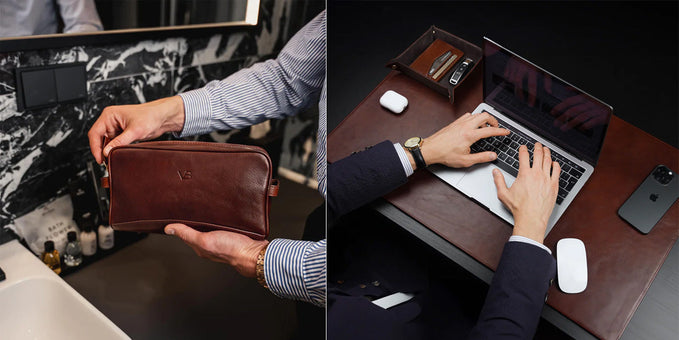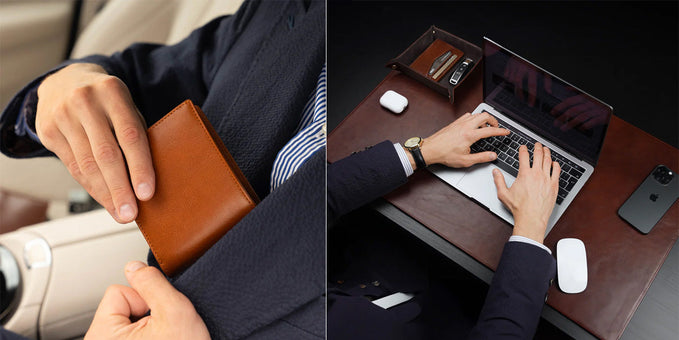Pebbled leather

Pebbled leather has a pebble beach-inspired texture and is on the level of patent in uniqueness.
Although it is being increasingly used in products from stylish cases for iPhones to designer backpacks, it remains somewhat mysterious.
If you have ever speculated on how the distinct pebbled texture is acquired or whether the leather is faux or real, now is the time to learn.
What is Pebbled Leather?
Also known as pebble-grain leather, it is any leather that has a bumpy embossing effect.
It is achieved in a tannery using extreme pressure and heat which gives a slightly raised and uneven surface.
This creates a particular appearance and makes it stand out from smoother textures.
Due to the process being straightforward, the pebbled pattern is applied easily to both real and faux leather. The term, in essence, refers to the texture and does not affect value.

Origins
Embossing is not a new technique. An old Scottish tale with roots in the 18th century argues that pebbled leather was invented by a native tanner.
The Tanner leaves a pile of hides on his workshop floor which was uneven and stony for a few weeks. When he returned, he saw that the bottom hide had been imprinted with a pebbled pattern. The weight of the other hides had caused the pressure. Another name for pebbled leather is Scotch grain, so perhaps the story has some truth.
The process of producing pebbled leather was certainly patented by the 19th century. A historical record exists of a patent application made by Mr. C. T. Woodman of Boston, Massachusetts, for an ornamenting improvement machine for leather pebbling in 1864.
The process, to this point, was laboriously slow and done by hand. The mechanized technique of Mr. Woodman required a minimum of exertion and revolutionized the pebbled leather finish process for tanners.
By the early 20th century, pebbled leather had become popular for making men’s shoes. Examples include loafers and derbies, which were eventually claimed in the high-fashion world by the likes of Chanel and Gucci, now known for their pebbled leather handbags.

Benefits of Pebbled Leather
Pebbled leather’s appeal lies in its sleek, eye-catching, and unusual appearance. It is a feature of contemporary accessories for men. It features in top-end designer products from Mulberry, Tom Ford backpacks, and Yves Saint-Laurent.
For some, the preference is traditional, smooth leather, for example, the Vachetta leather used in our refined everyday briefcase collection, and for others, the favorite is the unpolished look offered by pebbled leather.
Pebbled leather is also advantageous as it is less prone to be scratched and, at the least, doesn’t show scratches, and minor scuffing is hidden by the partially raised surface and irregular pattern. Therefore, purveyors of fine leather goods who may be prone to accidents could find that pebbled leather is for them.
The argument for pebbled leather includes its sustainability. During the process of tanning, a common occurrence is that parts of the hide are discarded due to being perceived as imperfect.
These imperfections are often caused by bites and injuries sustained during the animal’s lifetime. This leather is robust but will be rejected due to its visual inconsistency.
The pebble pattern applied to these pieces of leather helps to revitalize them by hiding the defects perceived, and they can then be used instead of discarded to create leather goods of high quality. Therefore, embossing makes the industry a little more waste efficient.

Uses of pebbled leather
A wide variety of consumer goods incorporate pebbled leather. Beginning with shoes, during the early Victorian era, British elites had hunting shoes typically embellished with a distinct leather grain finish. Currently, brogues, moccasins, and Dr. Martens carry a similar pebbled finish.
Apart from the fact that we like to wear pebbled leather, in addition, we like to sit on it. Naturally, we mean upholstery. Adorning our living room furniture, car seats, and bar stools is pebbled leather.
In the USA, a particular and prominent use of pebbled leather is in the production of American footballs. Cowhide leather, not pigskin, which is a common misconception, is imprinted with a texture of pebble grain which aids the grip of the ball.
Related leather guides:
- Leather
- Faux leather
- Vegan leather
- Bonded vs faux vs real leather
- Bonded leather
- Genuine leather
- Pleather
- Top grain leather
- Leather types
- Where does leather come from
- Mushroom leather
- Napa leather
- Vegetable tanned leather
- Leather tanning
- What is artificial leather?
- What is full grain leather
How is pebble-grain leather made?
Pebbled leather modern production is fairly straightforward. It involves an upgrade of Mr. Woodman’s 19th-century pressing machine. Raw hides are tanned and dyed before the embossing takes place. More on these stages can be found in our leather tanning process article.
Leather sheets pass through an industrial metal press with the pebble pattern etched onto the upper plate. It is then stamped onto the leather forcibly, which causes the leather to be permanently and instantly embossed. Hydraulic rolling machines can also be used for leather imprinting.
After this, a variety of finishing treatments are applied to form the characteristics for eventual use. For example, surface treatments to waterproof, make it fire-retardant, gloss, or buff to produce a suede-like or napped finish.
Is it durable?
Pebbled leather embossed with a grain finish can be found at both ends of the price spectrum. Finally, the pebble process does not affect the longevity of the product, and its durability will depend on the quality of the leather.
The full-grain, vegetable-tanned leather used in our luxury leather bag range is from the strongest area of the hide, and the process of vegetable tanning enhances robustness. Imprinting a pebbled pattern will not affect inherent durability.
Cuts from cheaper, weaker areas of the hide will have an inferior shelf life. The application of a pebble finish will not affect resilience.
How to care for pebbled leather
Semi-regular cleaning and conditioning will keep a quality pebbled leather product looking better for longer.
Faux and natural pebbled leather is cleaned using a warm water-dampened microfiber cloth. A small patch test should be performed on a concealed section before applying it to the entire surface in small semi-circles to remove dirt. Another option is a soft brush to dislodge tough dirt.
Alternatively, difficult staining can be removed with a leather cleaner. We recommend searching for a purpose-made cleaner for your leather and always performing the patch test before use.
Leather conditioners are different, however. Leather is softened and nourished to prevent drying out. Do not use conditioners on faux leather as these synthetic materials don’t have surface pores to absorb conditioners, which means they cannot penetrate the surface and will become sticky.
The conditioner will greatly benefit natural pebbled leather with an application every few months. A light polish over wax is recommended to prevent thick wax build-up in the grooves, causing tackiness.
Related leather care guides:
- Leather guide for beginners
- What is leather patina
- How to reform a leather bag
- How to maintain leather bags
- Repair cracked leather
- How to clean leather bag
- How to restore faded leather bag
Is pebbled leather real leather?
Natural, imitation, and vegan types of leather can have a pebbled surface. Natural skins can have faults or scars on the surface, making them unsuitable for fine and polished items. However, the leather is still in superb shape.
Pebbled surface application will help to hide these flaws and create usable, functional pieces.
Full grain, best taken from the thickest part of the hide, can be pebbled or split (where the original hide is split into thin layers to increase the amount of product).
The technique is simply stamped onto the surface which makes it applicable to any type of leather. Pebbled leather is seen on a wide variety of items. It is prevalent in handbags, travel bags, briefcases, backpacks, luggage, shoes, apparel, boots, and upholstery to name a few.
Related articles:
Conclusion
We hope you enjoyed our article on pebbled leather.
If you have any questions or comments, contact us at info@vonbaer.com, or leave them in the comments.
Want to read more? Check out our related Leather pages here.

Author: Albert Varkki
Albert Varkki is the co-founder of Von Baer. He understands leather products as a consumer, supplier, and a manufacturer, helping you with the inside knowledge you need, to choose the perfect leather product for you.
We strive for the highest editorial standards, and to only publish accurate information on our website.
Leave a Comment
Your email address will not be published.






